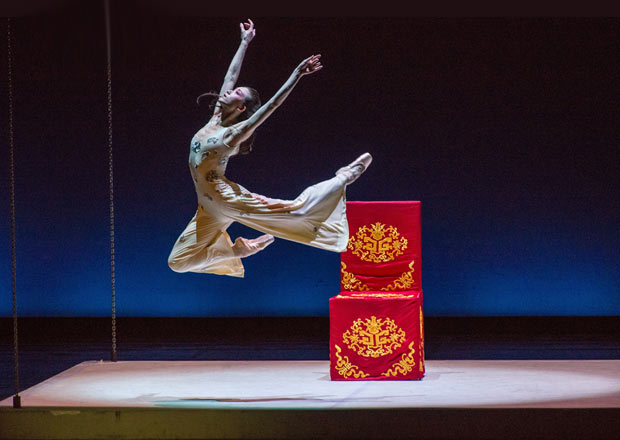
© Stephanie Berger Photography, Inc. 2015. (Click image for larger version)
National Ballet of China
at the Lincoln Center Festival
10: Peony Pavilion
12: Red Detachment of Women
New York, David H. Koch Theater
10, 12 July 2015
en.ballet.org.cn
www.lincolncenterfestival.org
Red Dreams
The past week as the Chinese stock market was imploding, the National Ballet of China has been dancing at the Lincoln Center Festival. This was the company’s first visit to New York since 2005, when it performed at BAM. On that occasion it brought a work based on the Zhang Yimou film Raise the Red Lantern. More recently a group of dancers from the troupe made a brief appearance at Fall for Dance. And now at the Koch they’re dancing two works that in many ways encapsulate the company’s past and present: The Red Detachment of Women, from 1964 and Peony Pavilion, from 2008.
The history of ballet in China is the history of a quest for identity. What stories should it tell? To what extent can it and should it reflect Chinese culture and traditional art forms like Chinese opera? What music should it employ? Ballet was introduced to China in the early twenties by Russian émigrés fleeing the Bolshevik Revolution. After the birth of the People’s Republic of China, ballet’s presence was solidified by the arrival of Soviet teachers. Then came the Sino-Soviet split, and Chinese ballet found itself on its own, cut off from its Russian ballet masters and choreographers. Judging by the company’s current visit, we can say that the pursuit of a national style is still very much a work-in-progress.

© National Ballet of China. (Click image for larger version)
In many respects, Red Detachment and Peony Pavilion could not be more unalike, but in a few, they are curiously similar. In both, the ballet vocabulary is very limited. Chinese choreographers seem to be enamored of a few iconic ballet steps and poses like the arabesque en pointe ‑ particularly fetching when the dancer is clutching a pistol, as in Red Detachment – and the renversé, a backward-arching turn that suggests yearning. Pirouettes and circles of leaps are also favorites, most notably in Red Detachment, a ballet in the heroic mold. Both ballets were made by committees, with multiple authors. (Red Detachment lists three choreographers; Peony has a director and a producer in addition to a choreographer, Fei Bo.) In both, more attention is placed on the manner in which the action is presented, the total effect of the work, than on the steps or the way they fit into the music. Both use music that relies heavily on Western symphonic tradition. Both have stylish, bold designs. Red Detachment is a fabulous example of poster art.
It’s also the more vivid of the two. It has the advantage of representing a slice of Chinese history. Where else in 2015, can one hear a chorus lustily humming the Internationale? (Or an audience clapping along to familiar revolutionary tunes?) The designs, by Ma Yunhong, are stunning: bright, saturated with color, strongly delineated. The ballet, which tells the story of an oppressed worker who joins a brigade of Red Army soldiers and returns to defeat her former tormentor, is set on the tropical island of Hainan. The skies are vibrant blue, the palm trees tall, the sliver of sea alluring. (There is also a fantastic storm, lit up by great flashes of lightning.) The costumes, too, are wonderful: crisp uniforms for the Red Army fighters, loose-fitting silk pajamas for the capitalist villains, and various forms of semi-local dress for the villagers. The highly conventional structure of the ballet makes room for folk ensembles – most of which have a distinctly Russian look – acrobatic fight scenes, stirring marches and a fantastic line of soldiers jetéing across the stage in a never-ending stream. Hurrah!

© National Ballet of China. (Click image for larger version)
But the truth is that neither Peony Pavilion nor Red Detachment is a great ballet. The main weakness is the rather limited choreography. In Peony Pavilion, there is the additional problem of muddled storytelling. (A five-year-old could understand the story of Red Detachment, and that was the point.) Peony distills a twenty-hour Kunqu opera, about a girl who dies of longing for a lover she imagines in a dream, into two. But it’s not only the ballet’s compressed narrative structure that is at fault, or even the weak link between movement and meaning. It’s something deeper: the overwhelming sense that the creators have reduced choreography to decoration, movement to ornamentation. Women sway and bend and unfurl their arms prettily, but, lovely as it all is, it means little. (Having just seen Kenneth MacMillan’s Chinese-inspired Song of the Earth, performed by the royal Ballet on the same stage, I found parallels between the two works. There, too, pretty gestures stand in for opaque emotions.)
The most interesting aspects of Peony are the delicate manner in which it handles the theme of sexual awakening – symbolized by the interplay of pointe shoe and bare foot – and its score. During the encounter between the heroine (Zhu Yan) and her lover (Ma Xiadong), the man removes the ballerina’s shoe and caresses her foot. Later he holds it to his chest like a talisman. His fascination with her feet borders on fetishism, but beyond that, it’s a powerful metaphor for dance, for the bound foot of the Chinese courtesan and the almost magical beauty of the ballerina’s foot on pointe. I found myself thinking of Cinderella, another story in which the heroine is the girl with the perfect foot, the one that fits into the tiny, pretty satin shoe.
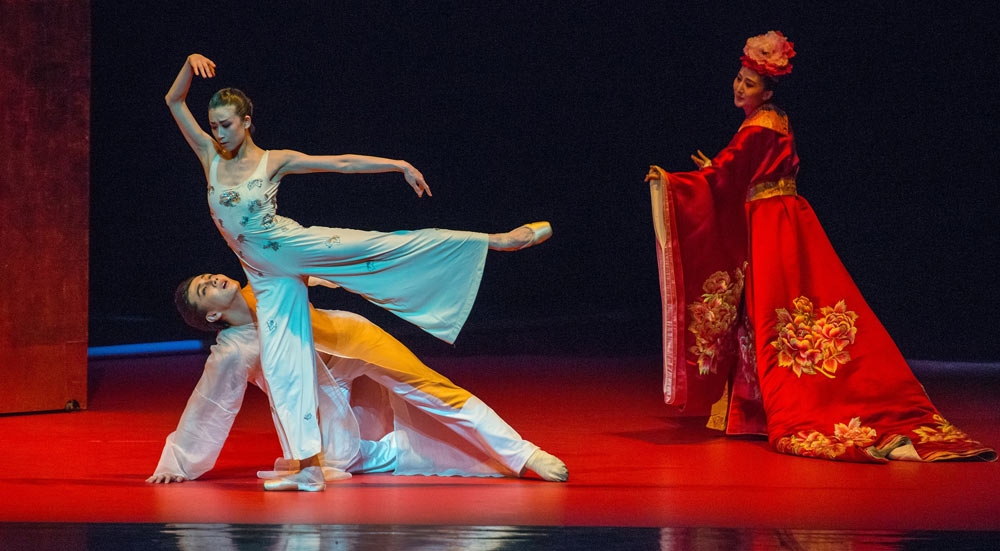
© Stephanie Berger Photography, Inc. 2015. (Click image for larger version)
The music by the Chinese composer Guo Wenjing also has its fascination. It combines elements of Kunqu opera – represented by a singer onstage in full traditional costume – with Western symphonic writing and lengthy quotations from Débussy’s Afternoon of a Faun (a returning motif), his Nocturnes, and Daphnis and Chloe, as well as the “Laideronnette, Imperatrice des Pagodes” section of Ravel’s Ma Mêre L’Oye, and music by Holst and Prokofiev, the latter for the underworld scenes. The intertwining of French impressionist music and Chinese opera works surprisingly well: just as the French were drawn to the tonalities, harmonies, and colors of the Far East, Chinese music has been deeply influenced by western composers. The two styles converse with surprising ease; to hear the singer, Yu Xuejiao, floating her silvery falsetto above Ravel’s shimmering washes of sound had an eerie rightness.
Also fascinating was the juxtaposition of the opera singer’s shuffling, gliding gait with the elegant, fluid motion of the ballet dancers. The two approaches to movement could not be more dissimilar, but they share a long history and an extreme refinement. These are ways of moving that take lifetimes to perfect. They complement each other; two great traditions, meeting on the timeless, borderless plane of the stage. So, too, the conversation between the Chinese love story, which transcends life and death, and the famous love stories of ballets past, many of which also play with the line between mortal and immortal love. One couldn’t help but think of the ghostly sylvan world of Giselle; the forest of nymphs in Sleeping Beauty’s vision scene; the lilting arms of the swan corps in Swan Lake. These ballets haunt Peony like past lives. Even more striking perhaps is the stately wedding procession with which it concludes, sustained by a majestic crescendo – an echo of the explosive finale of Stravinsky’s Firebird.
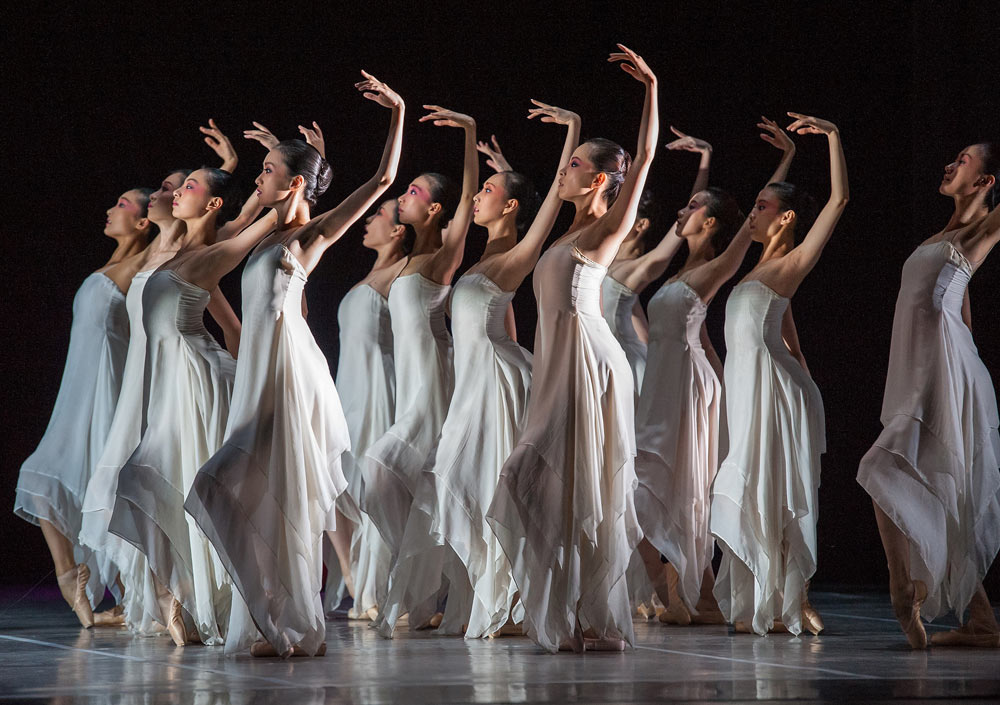
© Stephanie Berger Photography, Inc. 2015. (Click image for larger version)
The National Ballet of China dancers are beautifully trained, surprisingly tall, willowy – even the men – and delicately featured. This is a company that seems, in the main, to emphasize beauty of movement and harmoniousness over dynamism. Lu Na, the heroine of Red Detachment on July 12, had beautiful line but lacked power, particularly in jumps. (It must be said, this looks like an exhausting ballet.) Her counterpart in the role of the Red Army leader, Hong Changqing, was an exception among the men – a dancer in the heroic mold, big, broad-chested, square-jawed, and muscular, with a soaring jump and a plain, straightforward manner. A man you would trust your life to. Various smaller roles, especially for the villains, permitted the company to show off its acrobatic chops. But as a whole, the revolutionaries were a tad dainty.
Dancing the leading role of Du Liniang in Peony Pavilion, Zhu Yan was beauteous of physique and pristine of technique, with arched feet, long, floating arms and a mournful face. (Her expression never changed. Nor did those of the good-hearted characters in Red Detachment. Only the bad guys get to emote.) Zhang Jian, who played the part of Du Liniang’s passionate double, the Flower Goddess, was, if possible, even more beautiful, with a gorgeous arabesque radiating outward from her lower back. As the object of Du Liniang’s desires, Ma Xiaodong was lanky and elegant but showy, with a tendency to look up and puff out his chest and pause in beautiful poses. The company does not have a particularly emotive style but every aspect of its presentation – sets, dancing, costumes, technique – is consistently pleasing to the eye. Much emphasis is placed on the fluidity of the arms. The dancers’ hands are exquisite, with delicate, petal-like fingers.
The National Ballet of China can’t go on dancing Red Detachment forever. What can this ballet possibly mean to today’s young dancers? Peony Pavilion, for all its visual elegance and musical sophistication, is the creation of a choreographic tradition still in its infancy. What the company needs now is to produce some really good choreographers of its own.












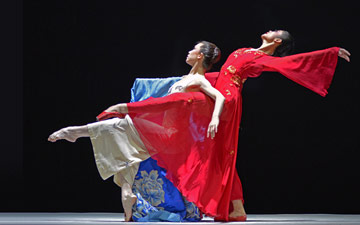
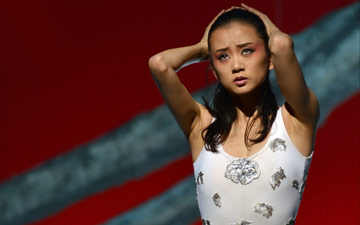


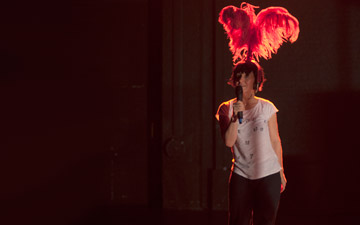
Vivid and specific reporting@
The story of Cinderella–a tale found in nearly every culture worldwide–is thought to have originated in China in the ninth century, I believe A.D.
Now it all makes sense!
What a superb, comprehensive review! It is so gratifying I will ask fellow Asian
Art Docents to read it. Dancetabs.is extremely fortunate to have you reviewing.
We are indeed!